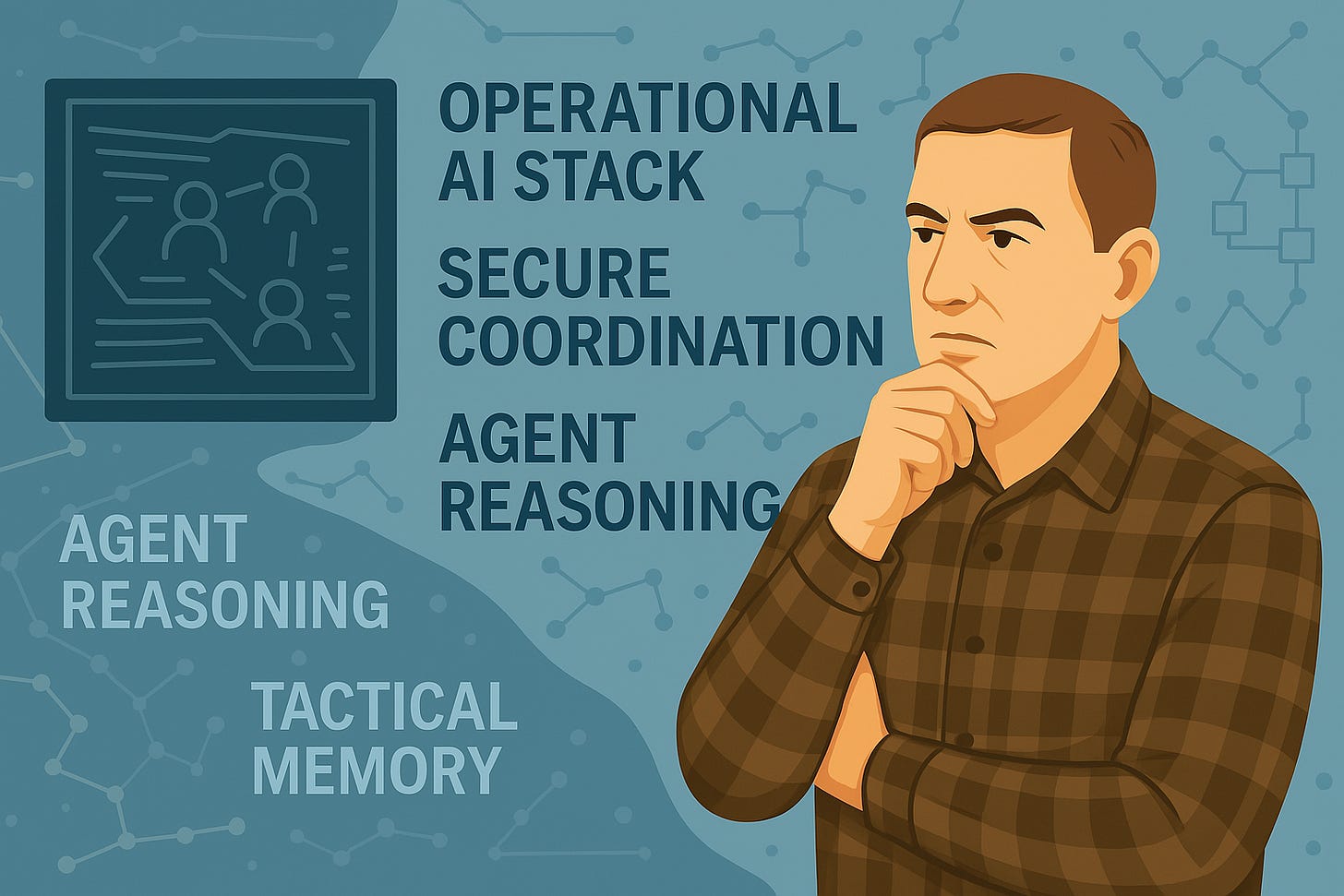Operational AI as a New Command Layer
Beyond Productivity Tools
The mission is not automation. The mission is agility under pressure.
Resilience, coordination, and fast, reasoned decision-making will define superiority.And those who design these systems—who understand the layers, limits, and levers of operational AI—will control the tempo and terrain of future conflict.
Modern AI systems—particularly agentic and autonomous ones—are not productivity engines. They offer the ability to:
Reason through ambiguous or conflicting information
Re-plan dynamically as input changes
Interface with multiple systems and data layers
Execute time-sensitive tasks semi-autonomously under uncertainty
That’s not office automation.
That’s battlefield orchestration.
The New Shape of AI Competition
While institutional actors may still be investing in inbox zero and automating meeting notes, militaries are experimenting with:
AI-augmented targeting systems
Multi-agent coordination in drone swarms
Deception-aware decision models
Denial-of-service attacks targeting cognition (e.g. prompt injection, hallucination loops)
This isn't speculative. It's observable in peer-state military research, experiments and exercises, and procurement strategies.
Architecting the Next Command Layer: A Full-Spectrum Operational AI Stack
This isn’t just about using AI—it’s about building the right system. In fast-moving, high-stakes environments, you need AI that can sense, understand, plan, and act. That means putting the right layers in place—from perception to execution—so your systems can operate under pressure and adapt as things change.
1. Sensing + Perception Layer
Sensor fusion (ISR platforms, EO/IR, radar, SIGINT)
Real-time data ingestion (low latency, edge-forward)
Multi-modal inputs (video, audio, telemetry, logs)
Situational context generation
Why it matters: AI-augmented targeting requires real-time understanding of the battlespace. This is not LLM territory—it’s deep learning fused with time-series, visual, and geospatial AI.
Examples: DARPA Perceptually-enabled Task Guidance, Project Maven
2. Reasoning + Planning Layer
LLMs + symbolic-neural reasoning models
World models and simulation (e.g. agents that predict “what-if” outcomes)
Tactical re-planning under uncertainty
Why it matters: You need more than text summaries. You need agents that understand operational goals, can re-plan dynamically, and operate under deception.
Examples: OpenSpiel (DeepMind), partially observable Markov decision process (POMDP) frameworks, DoD Autonomy Pathways
3. Memory + Knowledge Layer
Retrieval-Augmented Generation (RAG) for recall
World-state tracking and belief modeling
Graph-based memory (mission state, entity networks, threat signatures)
Why it matters: Operational AI systems must remember and reason—not just retrieve documents. Agents need working memory and mental models—not just search indexes.
Examples: Anthropic’s Constitutional AI, GraphRAG, LangChain
4. Coordination + Communication Layer
Multi-agent communication protocols (MCP, LangGraph, blackboards)
Memory/state sync across agents
Consensus and voting systems for autonomous fallback
Info ops resistance via message shaping and deception detection
Why it matters: In degraded comms or swarm coordination, you need structured inter-agent communication and fallback logic.
Examples: MCP, LangGraph, inter-agent blackboard architectures
5. Action Execution Layer
Secure APIs and robotic interfaces
Latency-tuned control for edge ops
Auditable commands to C2 systems, drones, autonomous platforms
Why it matters: Intelligence without action is irrelevant.
Execution chains must be secure, bounded, and verifiable.
Examples: Palantir AI Platform, Anduril Lattice, secure C2 bridges
6. Security + Control Layer
Prompt injection and hallucination containment
Deception-aware reasoning
Zero-trust network design and air-gapped models
Human-in/on-the-loop governance
Red teaming, audit logs, anomaly detection
Why it matters: You’re in a cognitive war. If your system can be spoofed, tricked, or misled—it’s not a weapon, it’s a liability.
Examples: OpenAI & Microsoft prompt injection papers, Anthropic red teaming
Final Word
AI is not just changing tools.
It’s rewriting how coordination, decision-making, and action flow under pressure.
You are not a tech implementer.
You are architecting the next layer of command.
And those who shape these systems—who understand their components, risks, and control points—will control the tempo and terrain of future conflict.
Disclaimer:
This post reflects a synthesis of open-source information, emerging AI research directions, and foresight-informed analysis. It is intended to help understand how AI capabilities are evolving—from narrow tools into integrated, adaptive systems with command-level implications. The goal is not to prescribe a specific architecture, but to offer a framing that supports strategic reflection, technical exploration, and responsible design.


